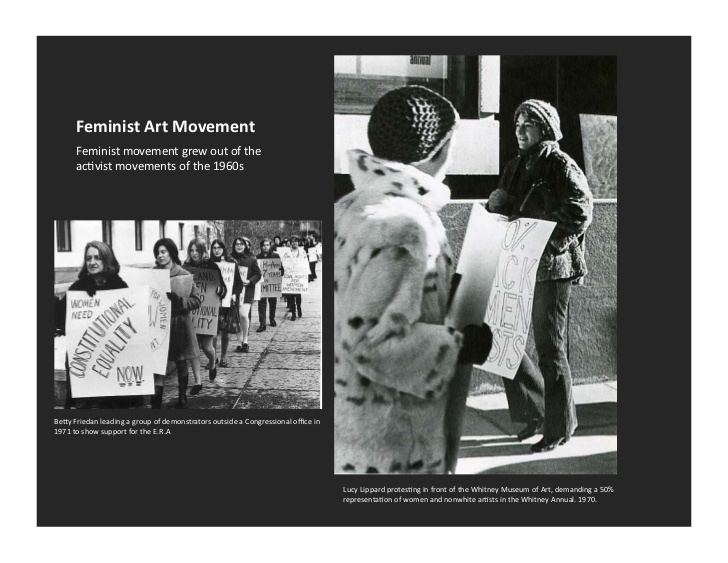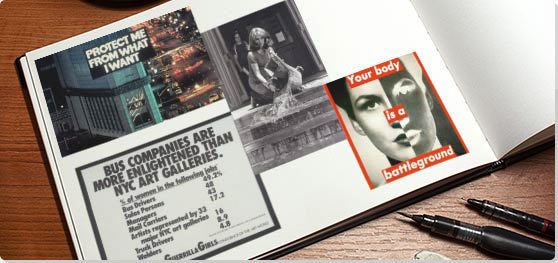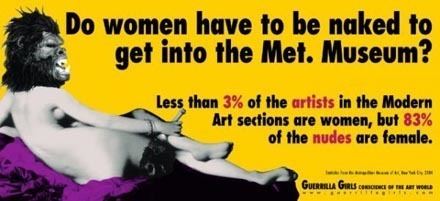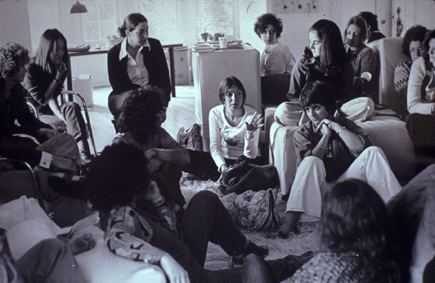 | ||
The feminist art movement refers to the efforts and accomplishments of feminists internationally to produce art that reflects women's lives and experiences, as well as to change the foundation for the production and reception of contemporary art. It also sought to bring more visibility to women within art history and art practice. Corresponding with general developments within feminism, and often including such self-organizing tactics as the consciousness-raising group, the movement began in the 1960s and flourished throughout the 1970s as an outgrowth of the so-called second wave of feminism. It has been called "the most influential international movement of any during the postwar period."
Contents

Guerrilla activity battling unjust traditions through the feminist art movement
History

The 1960s was period of civil rights and gay and lesbian rights movements and protests against war. It was also a period when women artists wanted to gain equal rights as men within the established art world, influenced by modernist movements "utopian ideals," and to create feminist art, often in non-traditional ways, to help "change the world."

Louise Bourgeois (1911-2010) and German-American Eva Hesse (1936-1970) explore some of the themes in feminist art, like domestic life, personal experience and the women's body.
On 20 July 1964 Yoko Ono, an avant-garde artist, singer, and activist, presented Cut Piece at the Yamaichi Concert Hall, Kyoto, Japan where she sat still as parts of her clothing were cut off of her, which meant to protest violence against women. She performed it again at Carnegie Hall in 1965. Her son, Sean, participated in the artist performance on 15 September 2013 at the Théâtre le Ranelagh in Paris. The Guardian's Jonathan Jones considered it "one of the 10 most shocking performance artworks ever."

Women artists, motivated by feminist theory and the feminist movement, began the feminist art movement in the 1970s. Feminist art represented a shift away from modernism, where art made by women was put in a different class to works made by men. Or, as Griselda Pollock and Roszika Parker put it—a separation of Art with a capital "A" from art made by women produced a "feminine stereotype".
This demand for equality in representation was codified in the Art Workers' Coalition's (AWC) Statement of Demands, which was developed in 1969 and published in definitive form in March 1970. The AWC was set up to defend the rights of artists and force museums and galleries to reform their practices. While the coalition sprung up as a protest movement following Greek kinetic sculptor Panagiotis "Takis" Vassilakis's physical removal of his work Tele-Sculpture(1960) from a 1969 exhibition at the Museum of Modern Art, New York, it quickly issued a broad list of demands to 'art museums in general'.
Alongside calls for free admission, better representation of ethnic minorities, late openings and an agreement that galleries would not exhibit an artwork without the artist's consent, the AWC also demanded that museums 'encourage female artists to overcome centuries of damage done to the image of the female as an artist by establishing equal representation of the sexes in exhibitions, museum purchases and on selection committees'.
There are also feminist forms of postmodernism which emerged in the 1980s. The feminist art movement grew out of the struggle to find a new way to express sexual, material, social and political aspects of life, and femininity. Feminist art movements emerged in the United States; Europe, including Spain; Australia; Canada; and Latin America in the 1970s.
Since then, there are women's art movements in Sweden, Denmark and Norway, Russia, and Japan. Women artists from Asia, Africa and particularly Eastern Europe emerged in large numbers onto the international art scene in the late 1980s and 1990s as contemporary art became popular worldwide.
Major exhibitions of contemporary women artists include WACK! Art and the Feminist Revolution curated by Connie Butler, SF MOMA, 2007, Global Feminisms curated by Linda Nochlin and Maura Reilly at the Brooklyn Museum, 2007, Rebelle, curated by Mirjam Westen at MMKA, Arnheim, 2009, Kiss Kiss Bang Bang! 45 Years of Art and Feminism curated by Xavier Arakistan at Bilbao Fine Arts Museum, 2007, Elles at Centre Pompidou in Paris (2009-2011), which also toured to Seattle Art Museum. have been increasingly international in their selection. This shift is also reflected in journals set up in the 1990s like n.paradoxa.
